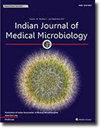商用实时荧光定量PCR试剂盒检测粪便样品中幽门螺杆菌和克拉霉素耐药性的结果
IF 1.4
4区 医学
Q4 IMMUNOLOGY
引用次数: 0
摘要
幽门螺杆菌(h.p ylori)是一种感染世界上一半人口的细菌,如果不治疗,它的定植通常会持续一生。无创检测幽门螺杆菌感染确实是有价值的,因为它们易于使用和减少不适。然而,许多非侵入性检测主要侧重于识别细菌的存在,而不是确定抗菌药物的敏感性。本工作的目的是利用粪便样品的实时PCR鉴定幽门螺杆菌感染和导致克拉霉素耐药的点突变。方法选取2021年1月至2022年7月在哈希特佩大学附属医院消化内科就诊的63例患者。采用胃活检培养、快速脲酶试验、组织病理学分析、粪便抗原试验、胃活检和粪便实时荧光定量PCR (RT-PCR)方法诊断幽门螺杆菌。作为本研究的参考标准,采用两种阳性方法的组合。结果纳入研究的63例患者中,42.9%的患者幽门螺杆菌检测呈阳性,57.1%的患者幽门螺杆菌检测呈阴性。当对照品与粪便RT-PCR比较时;幽门螺杆菌检测的敏感性、特异性、阳性预测值、阴性预测值和诊断准确率分别为66.6%、100%、100%、80.0%、85.7%。在用RT-PCR检测粪便样本中的克拉霉素点突变时,与胃活检RT-PCR获得的结果相比,总体一致性为65%。总之,本研究结果表明,利用粪便样本的RT-PCR作为检测幽门螺杆菌的诊断工具具有潜力。这在侵入性检查存在挑战的情况下尤为重要。然而,建议进一步研究以验证和完善克拉霉素耐药检测方法。本文章由计算机程序翻译,如有差异,请以英文原文为准。
Commercial real-time PCR kit results for the detection of Helicobacter pylori and clarithromycin resistance in stool samples
Introduction
Helicobacter pylori (H. pylori) is a bacterium that infects half of the world's population, and, unless treated, colonization usually persists throughout the lifespan. Noninvasive tests for the detection of H. pylori infections have indeed been valuable because of their ease of use and reduced discomfort. However, many noninvasive tests primarily focus on identifying the presence of bacteria rather than determining antimicrobial susceptibility. The purpose of this work was to use real-time PCR on stool samples to identify H. pylori infections and the point mutations that resulted in clarithromycin resistance.
Methods
A total of 63 patients attending to Gastroenterology Department of Hacettepe University Hospital were included between January 2021 and July 2022. Gastric biopsy culture, rapid urease test, histopathological analysis, stool antigen test, gastric biopsy and stool real-time PCR (RT-PCR) procedures were performed for the diagnosis of H. pylori. As the study's reference standard, a combination of two positive procedures were used.
Results
Among the 63 patients included in the study, 42.9 % tested H. pylori positive, while 57.1 % tested H. pylori negative. When the reference standards were compared to stool RT-PCR; for H. pylori detection, sensitivity, specificity, positive predictive value, negative predictive value and diagnostic accuracy were determined 66.6 %, 100 %, 100 %, 80.0 %, 85.7 % respectively. In the detection of clarithromycin point mutations from stool samples with RT-PCR, the overall agreement was 65 % when compared to the results obtained from gastric biopsy RT-PCR.
Conclusion
In conclusion, the outcomes of this study indicate that utilizing RT-PCR from stool samples holds potential as a diagnostic tool for detecting H. pylori. This is particularly relevant in circumstances where invasive tests present challenges. However, further studies are recommended to validate and refine the method for clarithromycin resistance detection.
求助全文
通过发布文献求助,成功后即可免费获取论文全文。
去求助
来源期刊

Indian Journal of Medical Microbiology
IMMUNOLOGY-
CiteScore
2.20
自引率
0.00%
发文量
154
审稿时长
73 days
期刊介绍:
Manuscripts of high standard in the form of original research, multicentric studies, meta analysis, are accepted. Current reports can be submitted as brief communications. Case reports must include review of current literature, clinical details, outcome and follow up. Letters to the editor must be a comment on or pertain to a manuscript already published in the IJMM or in relation to preliminary communication of a larger study.
Review articles, Special Articles or Guest Editorials are accepted on invitation.
 求助内容:
求助内容: 应助结果提醒方式:
应助结果提醒方式:


